Diagrams of Theory: Coleman's Boat
Note: I am in the process of moving to GitLab Pages and updating these posts.
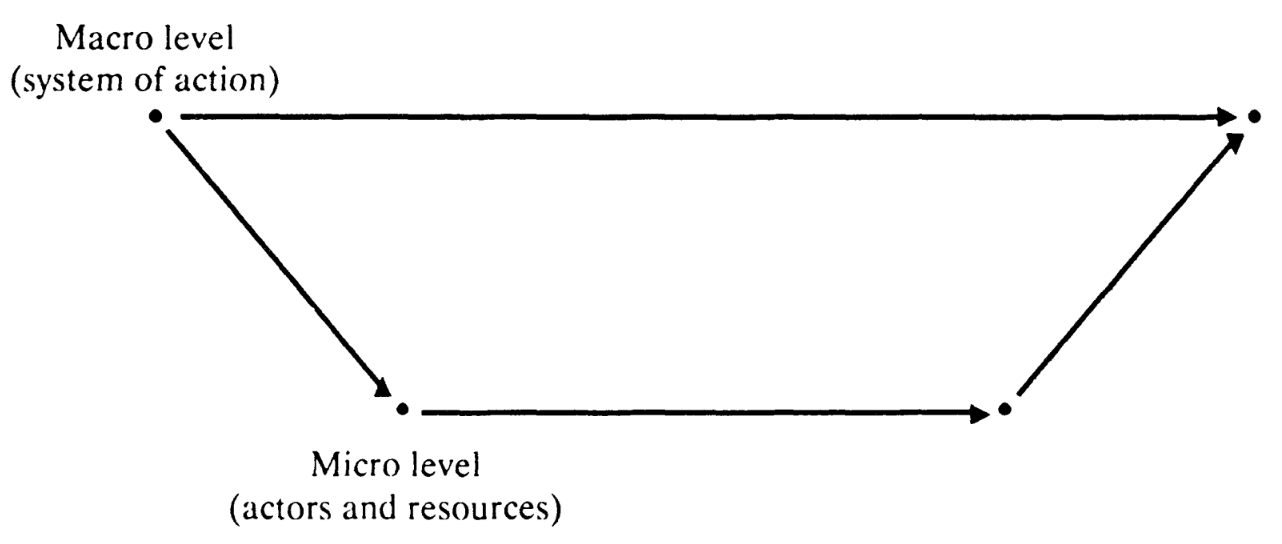
James Coleman’s oeuvre represents a significant contribution to general social theory, specifically sociological rational choice theory. Skimming Foundations of Social Theory (1990), we see several simple diagrams – mainly, lines with arrows. The most infamous is referred to as “Coleman’s Boat” pictured above, from Foundations (p. 702). Namely, because the upside-down trapezoid looks like a boat –although some allude to its affinity to a bathtub. So, sometimes it is “Coleman’s Bathtub.” According to Colin Beck (on Mastodon): “Morris [Zelditch] recounted that it was originally called a bathtub but when Coleman first presented it at a conferences an attendee yelled out ‘it’s a boat!’ And the name stuck. Perhaps apocryphal.”

Several authors propose that Coleman and Raymond Boudon converged on the same basic diagram (or, at least, the same basic form of explanation). Mario Bunge (1997:454), in outlining a “mechanistic” form of social explanation, details a few basic examples of the Macro-Micro-Macro approach using a slightly different visualization:
I call all of the above Boudon-Coleman diagrams, in honor of two eminent sociologists who have used them consistently (Bunge 1996). I suggest that, despite their professed methodological individualism, both scientists have actually adopted a systemic approach and have shown how to disclose social mechanisms by analyzing social systems into their components and their mutual relations (Boudon 1979; Coleman 1990). Thus, they are closet systemists-as Coleman himself admitted in a letter to the writer.
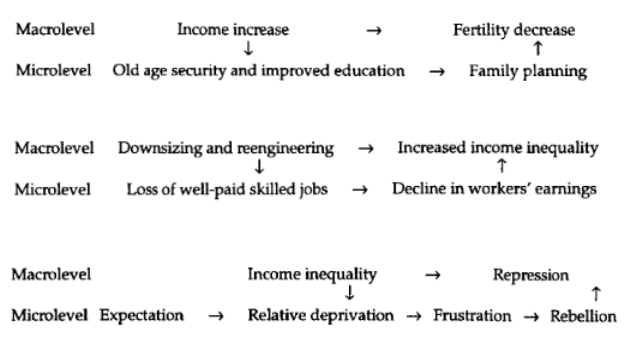
Gianluca Manzo (2007), drawing on Bunge, also notes the resemblances between Coleman and Boudon’s model of macro-micro linkage and suggest that both sociologists should be the namesake of The Boat. Here Manzo also ties the macro to the concept of “structure” and the micro to the concept of “action” – and “interaction” being the links between the two.
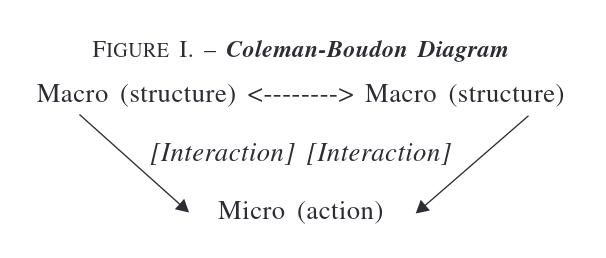
Another key citation of the diagram comes from Hedstrom and Swedberg (1998). Although they do not make the explicit connection between Coleman and Boudon regarding The Boat, Boudon does feature prominently in their discussion of mechanistic explanations in sociology. Here, The Boat is used to typologize “social mechanisms” (1998:21):
As several authors in this book point out, explanations of most concrete social events or states require resort to several elementary mechanisms; one is not enough. Sometimes these mechanisms counteract one another, and sometimes they work together. In any case, the multiplicity of mechanisms makes it important to introduce some kind of typology that sorts them in a meaningful way. The one we shall present here takes its departure from James Coleman’s (1986) well-known model for how to conceptualize collective social action, the so-called macro-micro-macro model.
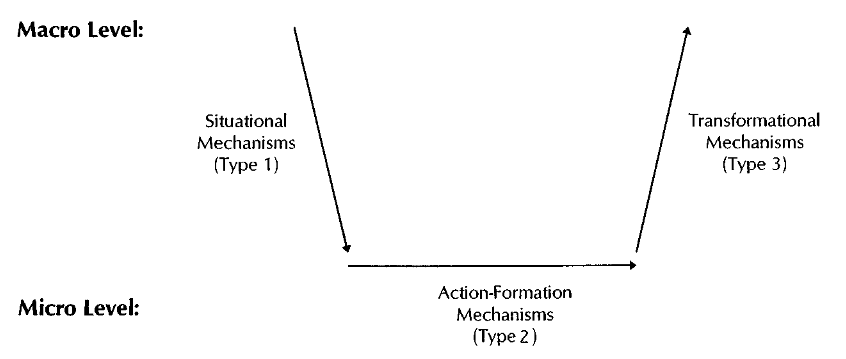
Diverging somewhat from this mechanistic tradition, the neoinstitutionalists, Jepperson and Meyer (2011:55), also label The Boat the “Boudon-Coleman” diagram (and see below where they also take the liberty to jazz it up).
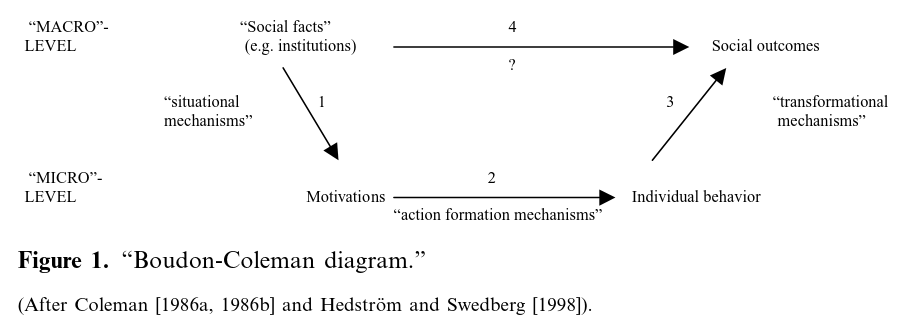
More recently, Raub and Voss (2017) and Van Assen, Buskens, Raub (2011) explore several “antecedents” to The Boat in the work of European sociologists.

Raub et al (2011:10) specifically note the work of Lindenberg:
Quite some time before Coleman pushed the idea, Lindenberg (1977; see also Wippler and Lindenberg, 1987) had developed a scheme for explaining macro-phenomena comprising exactly the components of Coleman’s scheme, albeit organized in a somewhat different way, namely, adapting the Hempel-Oppenheim model (Hempel, 1965) of explanation…
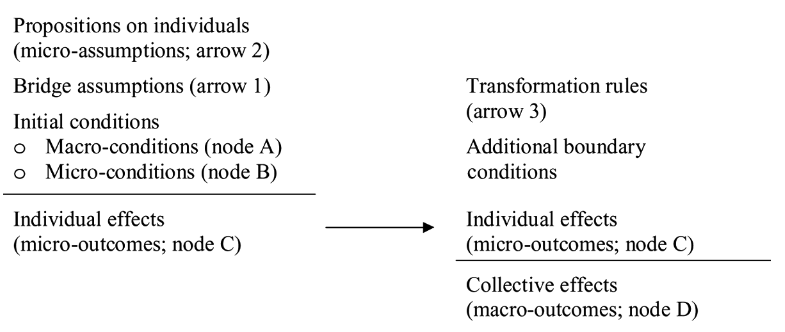
They also track down possibly the first version Coleman offers in a 1984 article “Micro Foundations and Macrosocial Behavior” which I believe was later republished as a chapter of the same name in the edited volume The Micro-Macro Link (Alexander 1987).
In this chapter, Coleman uses his boat often.
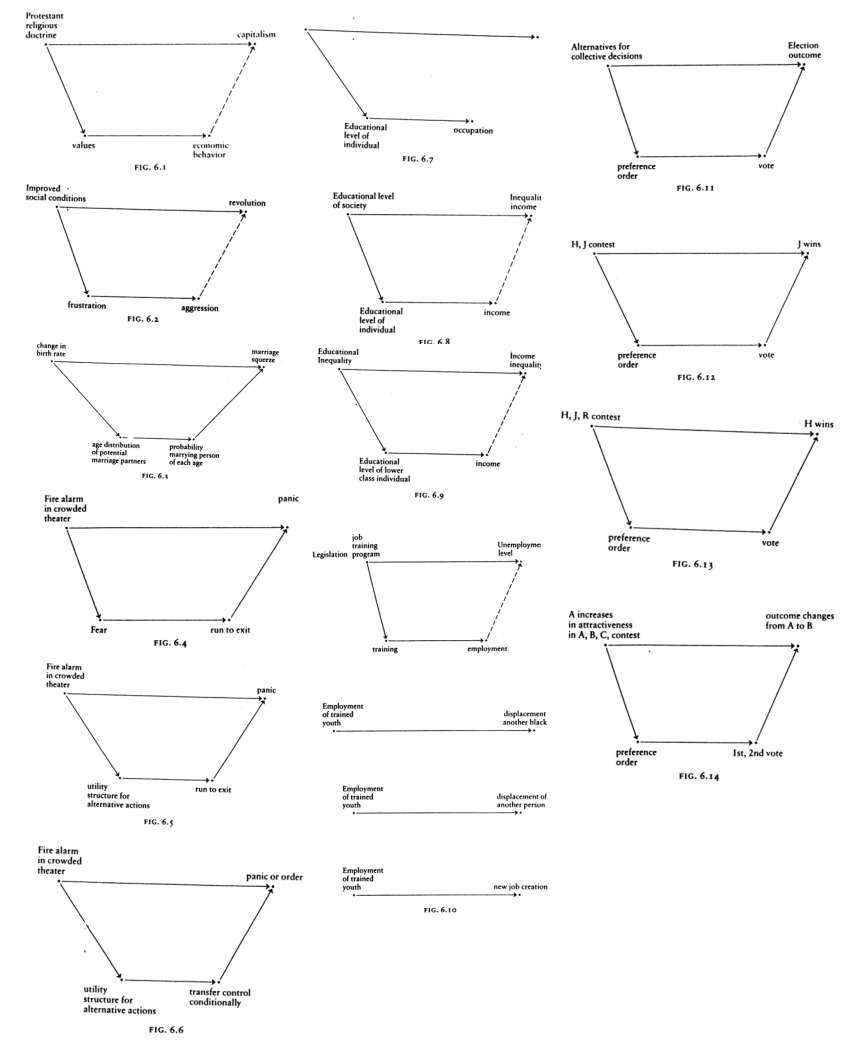
Linking Macro to Micro to Macro #
The infamy of the diagram is perhaps a result of its simplicity, and that it paints a picture of a form of “methodological individualism” – a “special variant” in Coleman’s words (1990:5) – that also incorporates social structural or situational constraints. Thus, some refer to it as “structural individualism.” Coleman uses it to explain how micro-level action is linked to macro level structures (and vice versa). As Yoshimichi Sato writes for the ISA’s blog, a full explanation addresses three questions:
- How macro factor (X) creates constraints on actors
- How actors choose actions under these constraints
- How the actions accumulate to (Y) the macro level

To use The Boat, one only need fill in the blanks. In Foundations, Coleman demonstrates the macro-micro-macro linkages with what he calls “frustration theories” of revolution. The social condition (macro) leads to frustrations among individuals (micro/attitude) which leads to aggression (micro/behavior), ultimately resulting in revolution (macro).
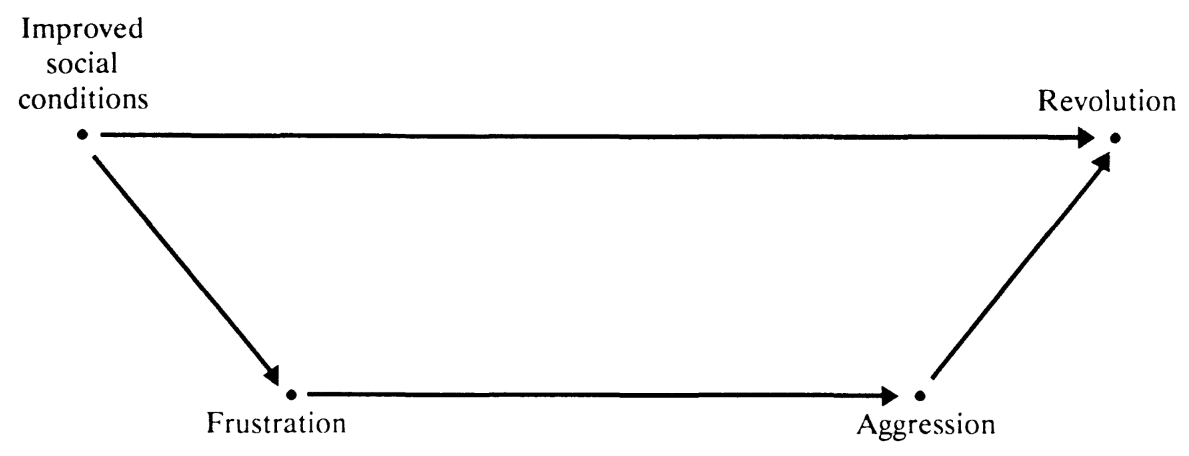
Coleman, perhaps first uses The Boat in his interpretation of Max Weber’s thesis in The Protestant Ethic and the Spirit of Capitalism. Coleman argues that Weber’s basic thesis is: “The religious ethic that characterized those societies that became Protestant during the Reformation… contained values that facilitated the growth of capitalist economic organization” (1987:154). In other words, one “macro” social fact leads to another “macro” social fact.

According to Coleman, this “single proposition” becomes three (1987:154-5):
- Protestant religious doctrine generates certain values in its adherents
- Individuals with certain values… adopt certain kinds of orientations toward economic behavior
- Certain orientations toward economic bheavior… on the part of individuals help bring about capitalist economic organization in a society
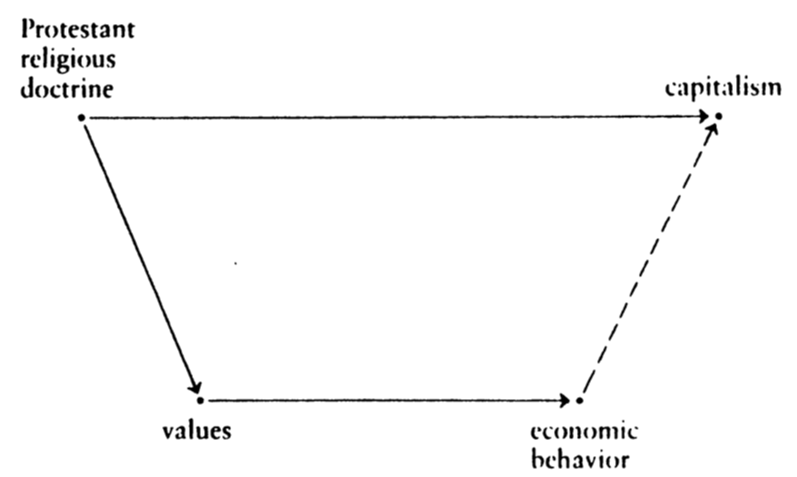
The weakest (and most interesting) part in Weber’s argument, according to Coleman, is the movement from micro to macro, the dotted line in the figure above (Coleman 1987:155):
In this set of propositions the third is of most interest, for it is the third which moves back up from the individual level to the societal level. This, in contrast to Durkheim’s work on suicide, in which the phenomenon of ultimate interest could be described as individual behavior, here the phenomenon of ultimate interest is clearly macrosocial, characterizing the society as a whole. It is in the third proposition that Weber’s theory is weakest, however, for it is here that some combination of individual actions is necessary to generate a macrosocial outcome.
Macro to Macro? #
The move from individual actions into macro social phenomenon – number 3 in the diagram below – is the most interesting part of the analysis, but for many discussion The Boat inspired, it is the macro-to-macro link that is worthy of consideration.

Although, Coleman indicates a causal line from Macro-to-Macro, this is not an actual casual pathway: “the macro level is an abstraction, nevertheless an important one” (1990:12). Indeed, this line represents precisely the kind of argumented Coleman attributes to Weber, which ultimately obfuscates explanation.

Hedstroom and Ylikoski have a dotted-line leading from macro to macro. This is intentional, as they agree with Coleman (to an extent) and argue that “explanations that simply relate macro properties to each other (arrow 4) are unsatisfactory” (2010:59). Hartmut Esser also includes a dotted line between the macro levels of Coleman’s Boat.
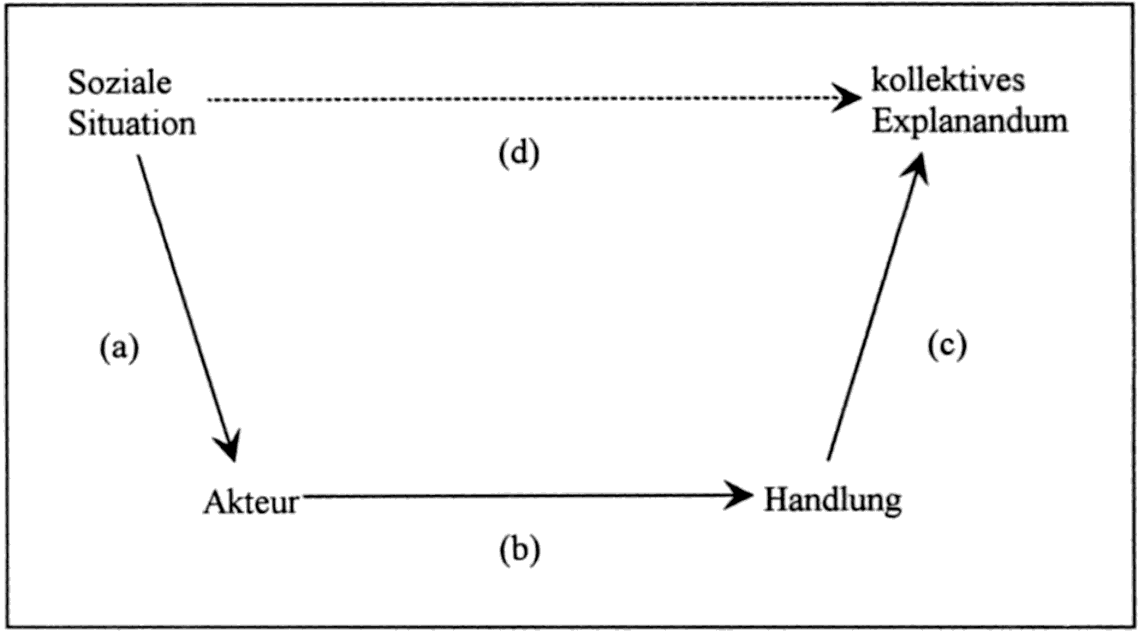

This linkage is also the most “controversial” aspect of this model is this macro-to-macro link. The blog Orgtheory devoted a small write-up, followed by a lively comment discussion over the possibility of macro-to-macro-level causality.
In an early version of The Boat diagram, Coleman goes further and removes the macro-macro link entirely (see below). Beginning by outlining the macro-to-macro link outlined by Weber’s thesis, as shown above, Coleman writes (1986:1321):
The characteristic problem in sociology is that of accounting for some aspect of the function ing of a social system. Put in causal diagram form, it can be seen as the effect of one macro-level variable on another, such as the effect of reli gious doctrine on the economic system (e.g., Max Weber’s general thesis in The Protestant Ethic and the Spirit of Capitalism).
Coleman diagrams the “methodological holism” implicit in Weber’s “macro-to-macro” thesis and adds the “corrective,” which shows the disaggregated, micro-level causal path of such an “abstracted” macro-macro link.
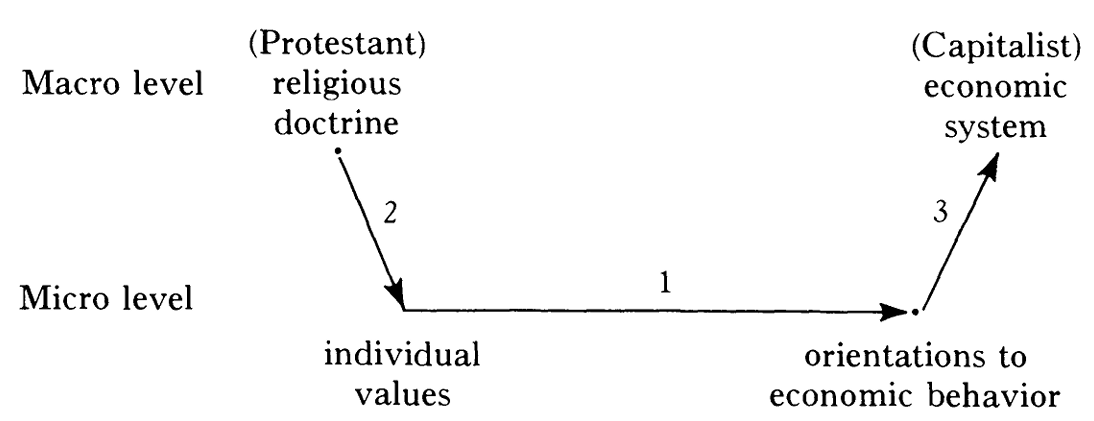
More Recent Elaborations #
Abell, Felin, and Foss use Coleman’s work in the study of strategy (Abell, Felin, and Foss 2008, Felin and Foss 2009).

Although sometimes made explicit, it is often presumed that arrows are not simply causal, but also temporal (and, yes, the former typically implies the latter). The diagram starts at Time^1 and ends at Time^2. Abell et al. make this temporal dimension even more apparent by chaining boats together.
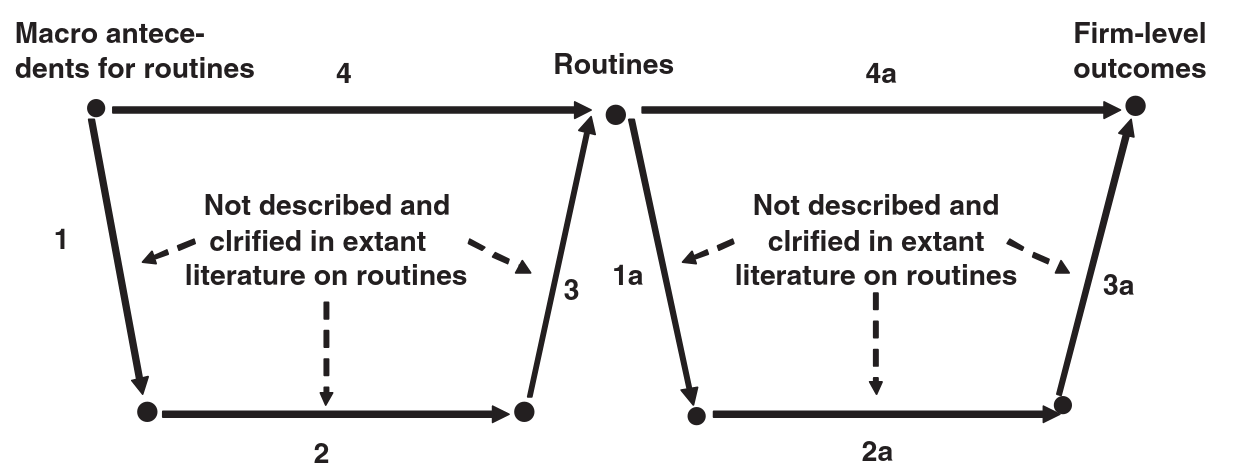
Another strand of theorization united under the banner of “institutional logics,” emerging from organizational sociology – and building on Abell, Felin, and Foss – invoked The Boat in an attempt to explain the “microfoundations” of (presumably “macro”) institutional logics.
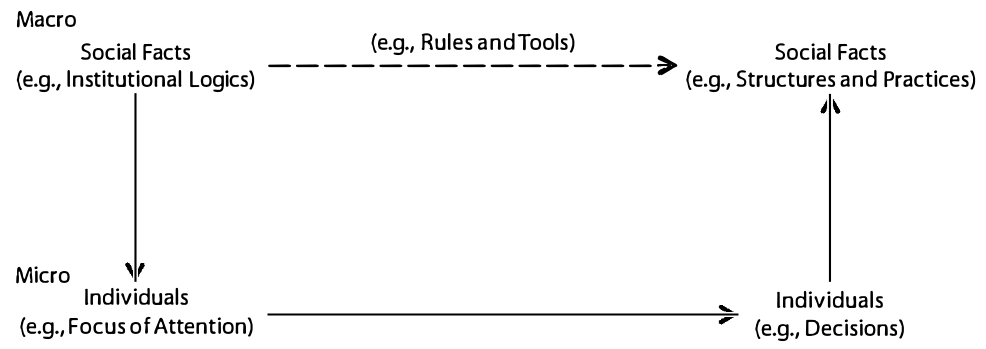
The authors then try to introduce dynamics, or a sense for how such institutional logics might change (similarly to attending to the role of “power,” contemporary sociology generally demands that any theory include a built in account of how change might occur). In so doing, they elaborate probably the most complicated version of the Coleman Boat (see below). There is a dotted line with an arrow from macro to macro and and solid line with an arrow going in the reverse direction – why are they different lines? We do not know.

Jepperson and Meyer, in their critique of the original Coleman Boat, let their stratified imagery of society drive conceptualization and, thus, provide an additional “meso” level.
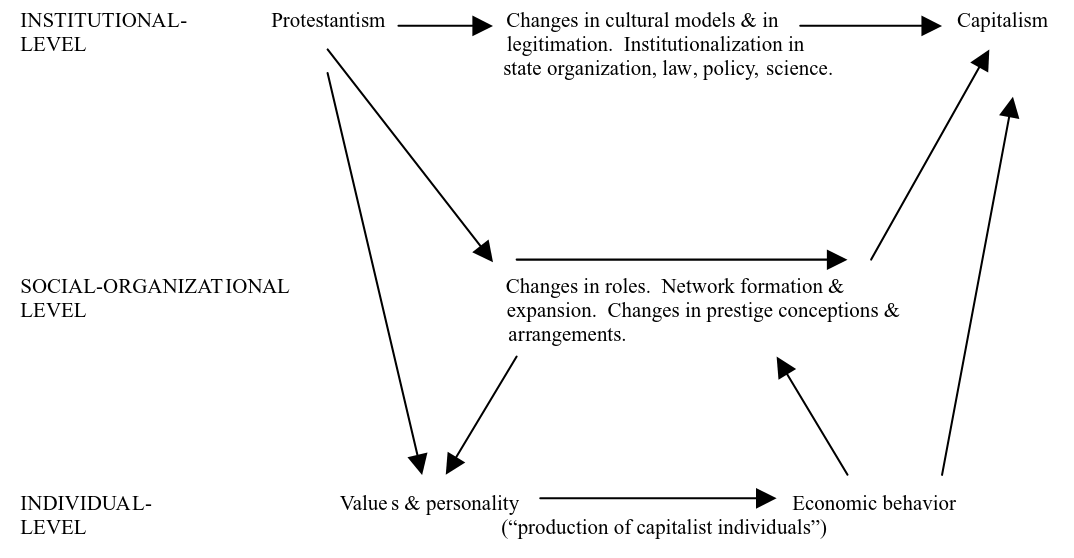
Finally, Franczak et al. (2023) take the “bathtub” a little more seriously and include the rubber ducky.
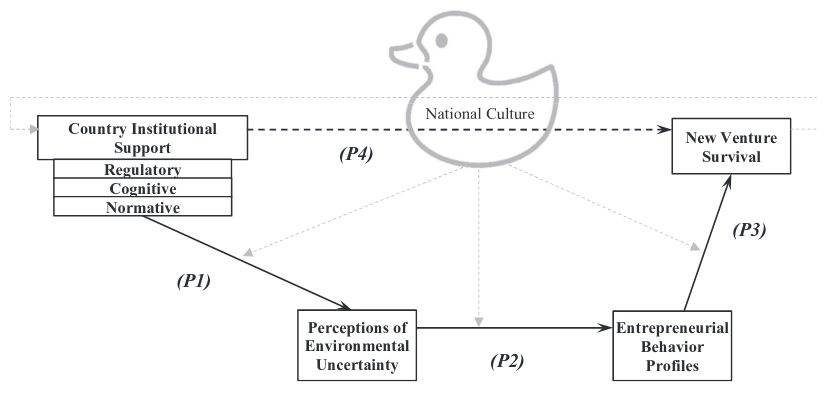
Epilogue #
I first wrote this post about a decade ago (Stoltz 2014). It went on to be the very first academic citation I received in Richard Swedberg’s “Can You Visualize Theory?” (2016). It was also published under a title that I no longer use (The Brief Note) and a URL I no longer own (thebriefnote.com, and now some cybersquatter is hoping one might pay two grand for it). I decided to update the post a bit, add some work published after the original post, and introduce a few more examples. Upon re-reading (and re-viewing) this work, what strikes me is the variation as to what is placed at the top and what is placed at the bottom – i.e. what we presume to be “macro” and “micro.” Of course, this only matters to the extent our theories require these levels (and the constituents) to actually exist. If we are simply using this as a useful heuristic for thinking and communicating about abstractions, there’s nothing to see here.
References #
Abell, P., Felin, T., & Foss, N. (2008). Building micro‐foundations for the routines, capabilities, and performance links. Managerial and decision economics, 29(6), 489-502.
Alexander, J. C. (Ed.). (1987). The micro-macro link. Univ of California Press.
Beck, C. [@cjb@sciences.social] (2023). “Morris Zeldtich recounted that it was originally called a bathtub…” Mastodon. https://sciences.social/@cjb/110299568118280234
Bunge, M. (1997). “Mechanism and explanation.” Philosophy of the Social Sciences, 27(4), 410-465.
Coleman, J. S. (1984). Micro foundations and macrosocial behavior. Angewandte Sozialforschung anc AIAS Informationen Wien, 12(1-2), 25-37.
Coleman, J. S. (1986). “Social theory, social research, and a theory of action.” American Journal of Sociology, 91(6), 1309-1335.
Coleman, J. S. (1987). “Microfoundations and Macrosocial Behavior,” pp. 153-176 in Jeffrey C. Alexander (ed.) The Micro-Macro Link. Berkeley.
Coleman, J. S. (1990). Foundations of social theory. Harvard University Press.
Esser, H. (1993). Soziologie: allgemeine grundlagen. Campus Verlag.
Hedström, P., and Swedberg, R. (Eds.). (1998). Social mechanisms: An analytical approach to social theory. Cambridge University Press.
Hempel, C. G. (1965). Aspects of scientific explanation (Vol. 1). New York: Free Press.
Jepperson, R., and Meyer, J. W. (2011). “Multiple levels of analysis and the limitations of methodological individualisms.” Sociological Theory, 29(1), 54-73.
Manzo, G. (2007). “Variables, mechanisms, and simulations: Can the three methods be synthesized? A critical analysis of the literature.” Revue française de sociologie, 48(5), 35-71.
Raub, W., Buskens, V., and Van Assen, M. (2011). “Micro-Macro Links and Microfoundations.” The Journal of mathematical sociology, 35(1-3).
Raub, W., and Voss, T. (2017). “Micro-macro models in sociology: Antecedents of Coleman’s diagram.” Social dilemmas, institutions, and the evolution of cooperation, 11-36.
Stoltz D. 2014. “Diagrams of Theory: Coleman’s Boat.” The Brief Note, January 26. (http://thebriefnote.com/2014/01/26/diagrams-of-theory-james-colemans-boat-bathtub/).
Swedberg, R. (2016). “Can you visualize theory? On the use of visual thinking in theory pictures, theorizing diagrams, and visual sketches.” Sociological Theory, 34(3), 250-275.
Weber, M. (2002). The Protestant Ethic and the Spirit of Capitalism. Penguin.